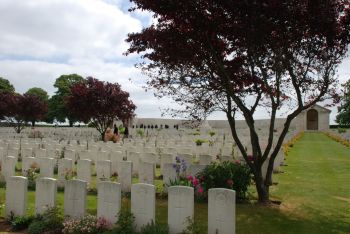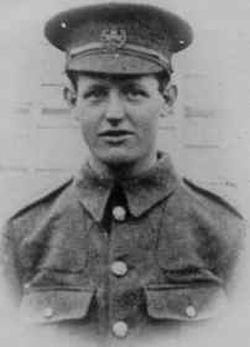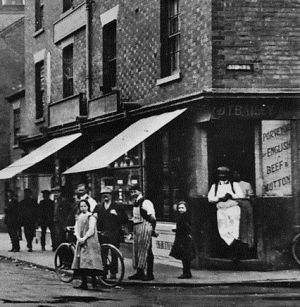|
|
| Home Topics Memorials Miscellany Transcripts References Family History Glossary Latest Beeston Blog About us | Site Search |
|
As George's Army Service Record has not survived, we do not have a precise record of when he enlisted, but we do know that it was at Nottingham and probably very early in 1916, originally with the 1/7th Battalion, Sherwood Foresters (Notts & Derby) Regiment5. This battalion had been mobilised within the first few days of War being declared on 4th August 1914, one of two Battalions formed at Nottingham with men from the Territorial Force which had originally left for France in March 1915. As one of the many volunteers added to the initial strength of the battalion, George would have started his training with the expectation that he would join the battalion in France later in 1916. However, developments elsewhere led to a change of plans. On 24 April 1916 - Easter Monday - 1200 members of the Irish Volunteers and Irish Citizen Army joined in a rising in Dublin, seizing important sites and proclaiming an Irish Republic. It was soon apparent that the units of the British Army that were in Ireland would not be able to cope so reinforcements were quickly summoned from England, consisting of two Infantry Brigades of the 59th North Midland Division which included men from several battalions of the Sherwood Foresters who were still under training. Private Letting was amongst these partly trained men who arrived in Ireland on Wednesday 26th April. Their task was be a difficult one for the inexperienced troops that were involved. made worse by the discovery that many of their weapons had been left behind and all they had were their rifles and bayonets - and they had had almost no training or experience with these. It was the start of a nightmare that would result in 23 deaths in the Brigade after they had marched into heavy fire and been forced to try to dislodge well positioned rebels. Only after further reinforcements and additional weapons arrived were they were able to prevail and the rebels surrended6. Following this early experience under fire, Private Letting continued training in England before being transferred to 10th Battalion, Royal Warwickshire Regiment and sent to France in September 1916, part of a draft of 300 men who arrived as reinforcement on the 21st. The battalion war diary records: "A draft of 300 R & F from 2/7th and 2/8th Notts & Derby Regt arrived at 3pm and were posted to Coys equalising their strength. The draft appears to be a fine one. No man with less than six months and a great number with 2 years Service. Almost all had been through (the) Irish Rebellion in Dublin. Almost none had been in France before."The battalion had been active in the Somme offensive since it had begun at the beginning of July and had already suffered heavy casualties during attacks at Millencourt, on High Wood and during the Battle of Pozieres Ridge. Private Letting and the other reinforcements that had arrived soon faced terrible conditions that were deteriorating rapidly. The battalion was involved inn the Battle of Ancre Heights, which had begun on October 1st, with the intention of advancing beyond the Thiepval Ridge towards Bapaume. By November, conditions were extreme, with heavy rain, thick mud and flooding making for miserable conditions in the trenches in particular. During this period, the battalion continued to take casualties in the course of several attacks on the enemy. On the 18th November, the battalion was in trenches, preparing for a major offensive against the enemy lines as part of the Battle of the Ancre. At zero hour, 6:10am, the men moved forward in half-platoon groups. The darkness and falling snow meant visibility was poor. By 6:30, it was reported that direction had been lost and the men had been unable to get through to their objectives. Some were ordered to withdraw. Enemy shelling was considerable and, together with machine gun fire continued to cause many casualties. While some men did eventually push through, they too were forced to withdraw. Casualties on the day included 2 Officers and 17 men killed, 3 Officers (2 believed killed) and 65 men were missing and 7 Officers and 121 men were wounded. Sadly, there was little to show for these heavy losses7. Private Letting was amongst those missing although, at some point, his body was recovered and identified and he was declared as having died on 18th November 1916. He is buried in Serre Road Cemetery No 2, in the village of Serre, 11 kilometres north-north-east of Albert. This cemetery was opened early in 1917, when graves were brought in from the area. After the Armistice, graves from a number of smaller cemeteries from the area were added. There are now 7,127 Commonwealth burials from the First World War in the cemetery, of which 4.944 are unidentified. George was posthumously awarded the British War Medal and the Victory Medal8. His remaining financial effects of £4 11s 9d were paid to his father on 30 April 1918 as was his War Gratuity of £3 on 29 October 19199. In addition to his entry on the Beeston memorial, he is also remembered on his home village memorial at Harlington in Bedfordshire10 That memorial also remembers George's brother, Private Thomas Lawrence Letting who died of influenza at Faversham, Kent on 15 February 1919 while serving with the Grenadier Guards and is buried in the churchyard at Biscot Bedfordshire10. George's youngest brother, Bernard Letting, died in 1945 while serving with the Royal Air Force and is buried in Denmark11. Footnotes 1The photograph of the Serre Road Cemetery No. 2 is from the Commonwealth War Graves Commission website. (http://www.cwgc.org) 2His birth was registered in Woburn Registration District (of which Harlington was part) in Q3/1892 (Ref 3b 392). His birth date is recorded as 21 August 1892 on the Harlington Roll of Honour website (www.roll-of-honour.com/Bedfordshire/HarlingtonRollofHonour.html> 3Harlington, Bedfordshire, 1901 Census, Piece 1505 Folio 77 George William's siblings were Bertha Rose (1890-1960), Violet Lily (1894-1972), Hilda May (1897-1973), Thomas Lawrence (1900-1919), Gladys (1902-1996, Cyril Robert (1904-1980), Stanley Leonard (1907-1997) and Bernard (1909-1945). 4Beeston, 1911 Census, Piece 20426 RD429 SD3 ED1 Schedule 199. 5Details of John's enlistment place and regiment are derived from his entry in 'Soldiers Died in the Great War' and his Medal Card. His entry on Harlington Roll of Honour website (www.roll-of-honour.com/Bedfordshire/HarlingtonRollofHonour.html> records that he enlisted in February 1916. The amount of his War Gratuity confirms that he had served for less than 12 months. It appears that, at some point, probably prior to or at the time of his posting to Ireland, George had been transferred to one of the other volunteer battalions of the Sherwood Foresters (2/5, 2/6 , 2/7 or 2/8 Battalion) 6This account of the Easter Rising and the Sherwood Foresters' involvement in it, is summarised mainly from the Wiki page at en.wikipedia.org/wiki/Easter_Rising. 7This account of the battalion's involvement in the The Battle of the Ancre is derived from its war diary. 8Details from George's Medal Card - available on ancestry.com. 9Details from "Army Register of Soldiers' Effects, 1901-1929" - available on ancestry.com. 10An obituary is on the Harlington Roll of Honour website (www.roll-of-honour.com/Bedfordshire/HarlingtonRollofHonour.html) 11Details of his burial and an image of his memorial stone is on the Find a Grave website at www.findagrave.com/cgi-bin/fg.cgi?page=gr&GSln=letting&GSbyrel=all&GSdyrel=all&GSob=n&GRid=15146638&df=all& |
|
|||||||||||
|
|
|||||||||||||

 George William Letting was born in Harlington, Bedfordshire in 18922, the second of nine children, the eldest son of James (1865-1960,
b. Westoning, Bedfordshire) and Elizabeth Letting (1863-1931, b. Toddington, Bedfordshire). James worked as a farm labourer. In 1901, the family were living
in a cottage at Goswell End, Harlington, Bedfordshire3. In 1905, Mary Childs (1881-1968), Elizabeth's youngest sister, married John Thomas Bailey
(1880-1940) who had begun to establish himself as a butcher in Beeston. By 1811, when the Bailey's were trading at 65 High Road, in the corner of Stoney Street,
Beeston, George William Letting had joined them, after leaving school, as an assistant butcher4.
George William Letting was born in Harlington, Bedfordshire in 18922, the second of nine children, the eldest son of James (1865-1960,
b. Westoning, Bedfordshire) and Elizabeth Letting (1863-1931, b. Toddington, Bedfordshire). James worked as a farm labourer. In 1901, the family were living
in a cottage at Goswell End, Harlington, Bedfordshire3. In 1905, Mary Childs (1881-1968), Elizabeth's youngest sister, married John Thomas Bailey
(1880-1940) who had begun to establish himself as a butcher in Beeston. By 1811, when the Bailey's were trading at 65 High Road, in the corner of Stoney Street,
Beeston, George William Letting had joined them, after leaving school, as an assistant butcher4. This well located shop is shown here (right) as part of the street scene, taken from a postcard produced in the years immediately before 1914. John and Mary Bailey pose
at the entrance to their shop while, it seems likely, George, wearing his butcher's apron, stands in front of the shop with others, watching the photographer record the scene
for posterity. Like everyone in the photograph, they could not have imagined the changes that would occur within just a few years which would dramatically alter or, indeed, tragically
end, their lives.
This well located shop is shown here (right) as part of the street scene, taken from a postcard produced in the years immediately before 1914. John and Mary Bailey pose
at the entrance to their shop while, it seems likely, George, wearing his butcher's apron, stands in front of the shop with others, watching the photographer record the scene
for posterity. Like everyone in the photograph, they could not have imagined the changes that would occur within just a few years which would dramatically alter or, indeed, tragically
end, their lives.